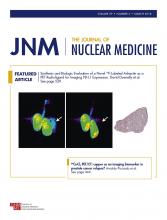REPLY: We would like to thank Hindié et al. for their interest in our preclinical and clinical works on radiolabeled somatostatin receptor antagonists (1,2). However, we feel that the title of their letter, “Advantages and Limits of Targeted Radionuclide Therapy with Somatostatin Antagonists,” is misleading because the letter does not address these 2 issues, but rather criticizes, a priori, the use of a higher mass of peptide for radionuclide therapy with radiolabeled somatostatin receptor antagonist. In our opinion, and based on our recent findings, the administration of an appropriate peptide mass is a key parameter for optimal imaging and therapy of somatostatin receptor–expressing tumors. We herein take the opportunity to respond to the valuable questions raised by Hindié et al., in addition to the already addressed points in our recent articles (1,3,4).
In our article presenting the outcome of animal studies (1), we acknowledged the complexity of translating from animal models to humans, as stressed by Hindié et al., and we cautiously stated that “considering several models, including body weight–based allometric scaling, 200 pmol may represent a peptide amount higher than 200 μg (up to 1,300 μg) in human.” Two hundred micrograms are considered the upper limit for the agonist; however, there are indications that 200 μg might represent a starting dose for the antagonists. We understand the limitation of allometric scaling from mice to humans (5) and therefore agree with the authors that the benefit (safety and efficacy) of injecting larger amounts of antagonist peptide still needs to be investigated clinically. Animal experiments have been crucial in discovering the potential benefit of higher peptide mass, and these results should not be neglected because of hypotheses that have not been demonstrated. Our mass-escalation study in mice clearly indicated that an optimized amount of antagonist might further improve the safety window of radionuclide therapy by reducing bone marrow and liver doses, as well as the effective dose of 177Lu-OPS201 (177Lu-DOTA-JR11). However, Hindié et al. focused on the reduction of the stomach and the pancreas uptake, arguing that the uptake in these organs is rather low in the human phase I trial with 2 microdoses (15 or 50 μg) of the imaging compound 68Ga-NODAGA-JR11 (68Ga-OPS202).
Although we agree with Hindié et al. that decreasing gastrointestinal or pancreatic uptake/dose may only be relevant in a diagnostic setting, we think that we should take maximum advantage of the mass effect for decreasing the bone marrow and liver dose that are absolutely relevant in systemic or liver-directed radionuclide therapy, in addition to the effective dose. Unfortunately, this approach does not affect renal uptake, which is mediated by another mechanism. Nevertheless, the kidneys do not seem to be the dose-limiting organ in 177Lu-based radionuclide therapy with somatostatin analogs, as shown by the NETTER-1 trial (6) and numerous previous other studies (7). In contrast and as recently presented by Reidy et al. (8), using a low peptide amount (100 μg) of 177Lu-OPS201 and standard activity (2 cycles up to 7.4 GBq) may lead not only to excellent objective response rate (>40%) but also to substantial bone marrow toxicity. In this sense, any attempts to maximize safety and efficacy are entirely justified.
Although a pharmacologic effect of somatostatin receptor antagonist cannot be completely excluded, especially at higher mass, there are no safety concerns based on preclinical toxicity data, even with 50 times more peptide than the corresponding upper limit of 1,300 μg in humans. Although the relevance of a possible symptom exacerbation, such as flushing, in patients with preexisting carcinoid syndrome remains questionable, one may recommend slow infusion over bolus injection to prevent triggering any pharmacologic effect.
An important property of the somatostatin receptor antagonist 177Lu-OPS201 is that it recognizes potentially more binding sites on tumor cells in vitro than the currently used agonists (Melpomeni Fani et al., unpublished data, 2016), similarly to previously published data (9–11). Organs that are physiologically expressing somatostatin receptors seem to get saturated—at least partially—earlier along the mass escalation, whereas tumor uptake remains high. Besides somatostatin receptor antagonists, these effects have also been observed for other radiolabeled peptides targeting G-protein–coupled receptors, such as 68Ga-/177Lu-NeoBOMB1, a novel gastrin-releasing peptide receptor antagonist (12). This phenomenon is an important property and it can be exploited, especially clinically, by increasing the injected amount of peptide, to improve the therapeutic index of targeted radionuclide therapy or, as Hindié et al. correctly mentioned, to maintain the use of cold somatostatin analog during targeted radionuclide therapy.
Therefore, we disagree with Hindié et al. that we should aim at “injecting the lowest mass of peptide that yields a satisfactory tumor uptake.” On the contrary, we believe that we should aim at injecting the optimal mass of somatostatin receptor antagonists that is safe and results in the best tumor-to-background (uptake/dose) ratio, to maximize the therapeutic index. It is still questionable if increased peptide mass will result in a reduced uptake in tumors with low receptor density; nevertheless, more than the absolute tumor uptake, what is clinically relevant is the therapeutic index represented by tumor–to–background dose ratios that may still be optimized if appropriate peptide mass is used. Of course, this consideration needs to be brought into a broader context of the individual patient, the clinical setting (whether imaging, theranostic, or therapeutic applications), the tumor type and grading (different receptor density), the tumor heterogeneity (intrapatient variability), and the tumor burden (interpatient variability).
We thank once more Hindié et al. for the stimulating discussion and for giving us the opportunity to clarify several important points.
Footnotes
Published online Nov. 16, 2017.
- © 2018 by the Society of Nuclear Medicine and Molecular Imaging.







